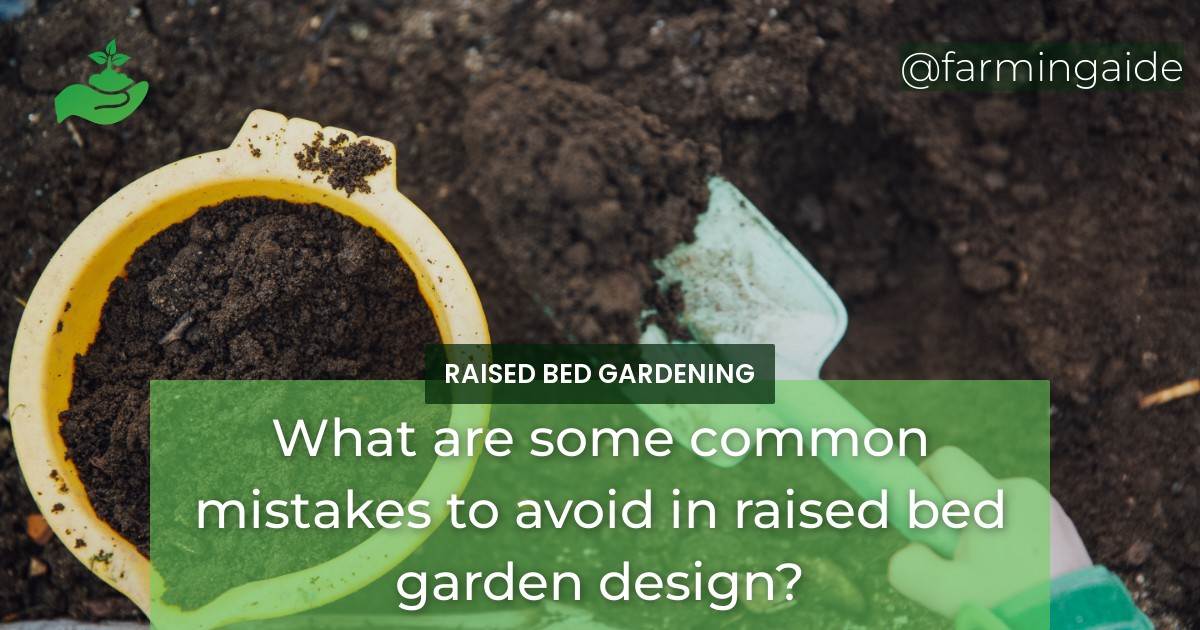When it comes to creating a successful raised bed garden, there are some common mistakes that should be avoided. By taking the time to plan and design your garden properly, you can avoid many of these common pitfalls and create a thriving garden. Let’s take a look at some of the most common mistakes to avoid in raised bed garden design.
Not Considering the Location
Choosing the right location is critical to the success of your raised bed garden. When selecting a site, consider the following:
Choosing the Wrong Site
- Avoid low-lying areas that are prone to flooding.
- Avoid areas with poor soil or that have been contaminated by chemicals.
- Choose a site that receives at least six hours of direct sunlight each day.
Not Enough Sunlight
Insufficient sunlight can lead to stunted growth and poor yields. Before you begin building your raised bed garden, make sure that the site receives adequate sunlight. If your garden is in a shaded area, consider using reflective surfaces to increase the amount of light that reaches your plants.
Poor Drainage
When designing your raised bed garden, ensure that water can drain freely from the soil. Poor drainage can cause root rot and other diseases, which can quickly decimate your plants. Consider adding a layer of gravel or sand at the bottom of your raised bed to improve drainage.
Incorrect Bed Size and Shape
The size and shape of your raised bed can have a significant impact on your garden’s success. Here are some common mistakes to avoid:
Beds Too Wide
When designing your raised bed, be careful not to make it too wide. It should be no wider than four feet so that you can easily reach the center of the bed without stepping on the soil. This can cause compaction and damage to your plants’ roots.
Beds Too Tall
While it may be tempting to create a raised bed that is as tall as possible, this can actually be detrimental to your plants’ health. Beds that are too tall can dry out more quickly and can become too hot, causing the soil to become sterile.
Choosing the Wrong Shapes
When designing your raised bed, consider the shape carefully. While round or oval beds may look attractive, they can be difficult to manage. Rectangular or square beds are generally easier to manage and can maximize the space in your garden.
ALSO READ
Poor Soil Quality
The quality of your soil is one of the most critical factors in the success of your raised bed garden. Here are some common mistakes to avoid:
Not Testing the Soil
Before you begin planting, it’s essential to test the soil to see if it has the right balance of nutrients and pH levels. Testing your soil can help you avoid over or under-fertilizing your plants, which can lead to poor yields or even plant death.
Using the Wrong Soil
Choosing the right type of soil is critical to the success of your raised bed garden. Avoid using topsoil, which can be too heavy and may contain weed seeds or other contaminants. Instead, opt for a high-quality potting mix that is specifically designed for raised bed gardening.
Overcrowding Plants
While it may be tempting to pack as many plants as possible into your raised bed, overcrowding can lead to poor yields and can make it difficult to manage your garden. Here are some common mistakes to avoid:
Not Enough Space
Each plant needs a certain amount of space to grow and thrive. When planning your garden, be sure to leave enough space between plants so that they can spread out and receive adequate sunlight and nutrients.
Planting Too Deep
When planting your seeds or seedlings, be careful not to plant them too deep. This can cause the roots to suffocate, leading to poor growth and yield.
ALSO READ
Neglecting Pest Control
One of the most significant challenges of raised bed gardening is controlling pests. Here are some common mistakes to avoid:
Not Planning Ahead
Prevention is key when it comes to pest control. Before you start planting, research the pests that are common in your area and take steps to prevent them from infesting your garden. This may include using row covers, companion planting, or other methods.
Not Considering Companion Planting
Companion planting is the practice of planting certain crops together to help deter pests and improve soil health. When planning your raised bed garden, consider incorporating companion plants that can help protect your crops.
Watering Mistakes
Watering is critical to the success of your raised bed garden. Here are some common mistakes to avoid:
Over or Underwatering
Watering your plants too much or too little can be detrimental to their health. Be sure to water your plants regularly, but avoid overwatering, which can lead to root rot and other diseases.
Inconsistent Watering
Inconsistent watering can lead to poor yields and can make it more challenging to manage your garden. Consider using a watering system that automatically waters your plants on a regular schedule.
Not Considering Maintenance
Maintaining your raised bed garden is critical to its success. Here are some common mistakes to avoid:
Lack of Access
Be sure to design your garden so that you can easily access all areas. This will make it easier to weed and harvest your crops and will help you avoid damaging your plants.
Not Planning for Crop Rotation
Crop rotation is the practice of planting different crops in the same area over time to help maintain soil health. When planning your garden, be sure to consider how you will rotate your crops to help prevent soil-borne diseases and pests.
How can I incorporate raised bed gardening into a fun and educational experience for children?
One way to make children’s gardening in raised beds a fun and educational experience is to involve them in the planning and planting process. Let them choose which vegetables and flowers to grow, teach them about soil health, and encourage them to keep a journal to track the growth of their plants.
Conclusion
By avoiding these common raised bed garden design mistakes, you can create a thriving garden that produces healthy and delicious crops. With a little planning and attention to detail, you can enjoy the many benefits of raised bed gardening for years to come.


